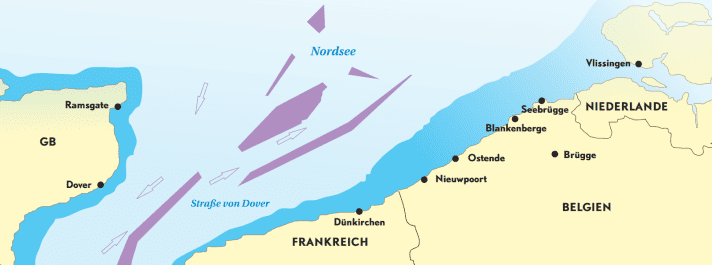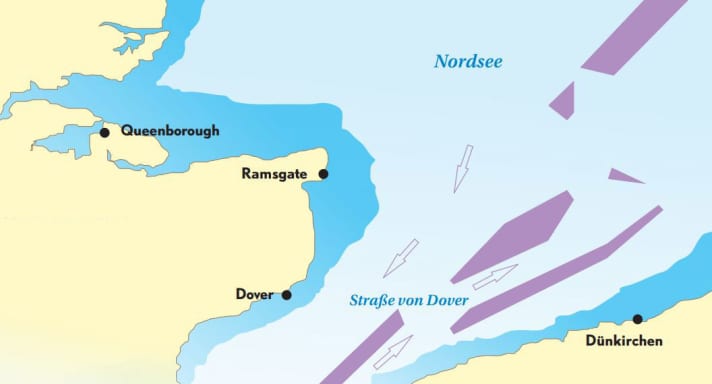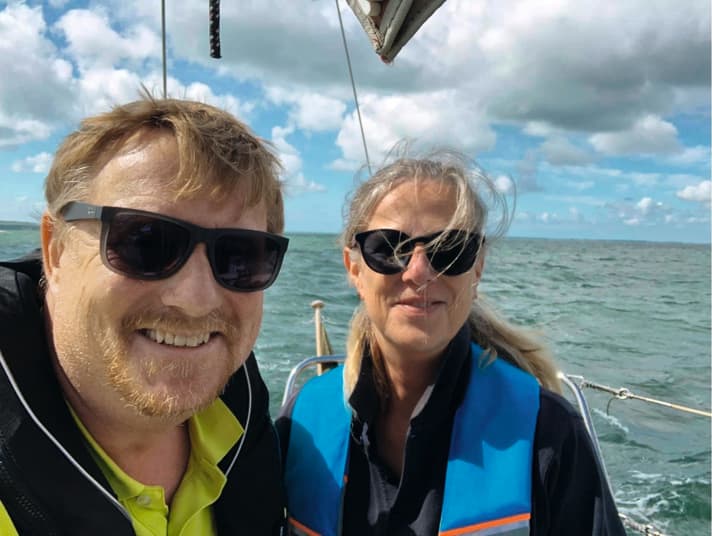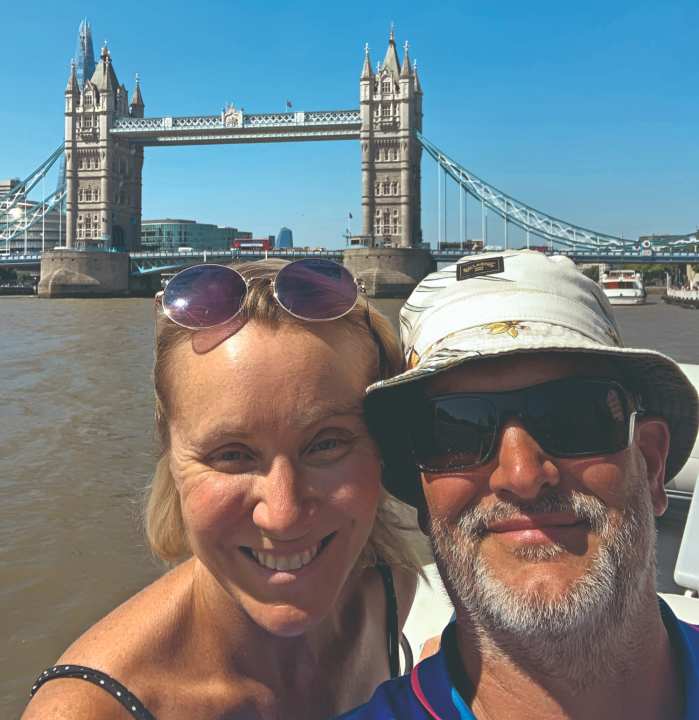





In this article:
Reaching a major city from the water is often something very special. For example Amsterdam, Hamburg, Copenhagen, Lisbon, Stockholm or: London. The British metropolis of nine million people is huge and has a lot to offer visitors. At first glance, it's not that far from the Netherlands. It is a good 120 nautical miles as the crow flies from Cadzand, the most south-westerly port in the neighbouring country, to the famous Tower Bridge. For a medium-sized yacht, that's just one etmal. But one that is quite a challenge.
The exit of the English Channel lies between the Netherlands and the British Isles. There is a lot of activity there. Lots of freighters, traffic separation schemes, wind farms and anchor fields. Full attention is required. If this is all too much for you at once, no problem, the route can be divided into manageable stages. Firstly, the course leads along the Belgian coast to Dunkirk and from there to Ramsgate. Then round the corner to Queenborough and from here directly to London. With a bit of luck, you'll also catch a tide that doesn't force the crew out of their berth too early. If, on the other hand, you are travelling directly from the north of the Netherlands to England, a night trip is unavoidable. The distance from IJmuiden to Harwich is around 120 nautical miles, which is also an etmal. From there it is also via Queenborough to the city on the Thames.
Southern route with several stopovers
If you choose the southern route, you will sail into the North Sea in Roompot or Vlissingen. Then it's time to cross the Westerschelde. In order to avoid the large ships off the Belgian coast, it is advisable to sail towards the harbour of Zeebrugge. You can spend the night here. If you also want to explore the area a little, you should take the tram to nearby Bruges. The city is beautiful and definitely worth a visit. Alternatively, you can turn off to starboard before entering the harbour and enter a fairway along the coast. This is where Blankenberge lies first. The journey can also be interrupted in this formerly fashionable seaside resort. However, the entrance is prone to silting up, and between October and May in particular, the skipper should enquire about the condition of the entrance beforehand on VHF channel 10.
Ostend and Nieuwpoort follow further along the coast, which is not really worth seeing. Both harbours are suitable for a stopover. In Nieuwpoort, however, there is a bar of 1.50 metres at low tide. And: in the approach to the harbour, there is a current of up to three knots in the narrow passage to the marinas.
However, Dunkirk is ideal for the crossing to Ramsgate. This lies behind the so-called Zuydcoote Pass, a narrow passage between two sandbanks that is well buoyed. From Dunkirk, most crews will want to complete the passage of the English Channel in daylight due to the heavy traffic. At the same time, you should make the most of the tide. If you start Dover six hours after high tide, you will have the current on your side all the way to the other side of the canal at around five knots through the water. At the Godwin cardinal buoy, however, the course changes to the north. This is the latest point at which you want the current to capsize, as it helps you on your way to Ramsgate.
Incidentally, a westerly setting current enables a slightly lower course to the wind in westerly winds, as the current offset compensates for this. However, there is then a wind-against-current situation, which makes for a somewhat choppier sea. You should be prepared for this.
The right tidal window makes travelling to England easier
After a good 40 nautical miles, the entrance to Ramsgate is finally reached. Yachts should use the "Recommended Yacht Track" south of the buoyed fairway and register on VHF channel 14 - and, if necessary, wait south of the entrance if freighters are entering or leaving. There is a strong cross current along the channel to the harbour. When approaching the harbour, counteract accordingly.
Next up is about 38 miles to Queenborough if you sail north round Margate Sand and Pan Sand - which is highly recommended by experienced sailors. The sands are constantly changing, and the deep water channels for large ships are well mapped and buoyed. A good starting window opens about two hours before high tide in Dover. Then the current helps most of the time. And if it capsizes, it only gets out of the Thames moderately. Once Pan Sand has passed, there are two ways to get to Queenborough. The easy one is the approach via the River Medway, the more difficult one via the Swale. As it is better to sail through this 14-mile-long, narrow fairway with rising water, the start time from Ramsgate is delayed: five hours before high water Dover is the earliest you should start the journey into the Swale. The Kingsferry Bridge can be opened to 29 metres above mean high water.
In Queenborough, the yacht moors at the jetty or at a Muringtonne. In this case, the crew can use a water taxi to get ashore. Don't be surprised: There can be up to six boats moored at a buoy at the same time.
If you start in the north of the Netherlands, you can sail across the North Sea from IJmuiden. Harwich is then a good stopover, specifically Shotley Marina, which is ideally located - also for a trip to the legendary "Pin Mill Pub". From there it is 58 miles to Queenborough. It usually takes so long that the tide is almost irrelevant. During the approximately twelve-hour journey, the tide cancels itself out.
The entrance to London is an experience
The queen's stage follows. The destination is St Katharine Docks. Although there are other marinas in London, you simply want to stay in this gem in the centre of the city right next to Tower Bridge. Even if it's not cheap: a ten-metre boat costs £93 per night. Nevertheless, there's nowhere better. But: make sure you book! Book on the harbour's website: www.skdocks.co.uk.
The 40 nautical miles from the River Medway to London fly by. To make the most of the tide, start in Queenborough at low tide. There is a lot to see on the banks. Above all, however, you pass the Thames Flood Barriers - nine openings with rotary gates to protect the town from flooding. Sailors register by radio on channel 14. Green lights indicate which passage is open. Never choose a different opening, as the gates may only be partially lowered.
The prime meridian is then waiting in Greenwich. From there, the numbers on the GPS get bigger again and there is a "W" behind them. A little later, you finally reach Tower Bridge.
Directly in front of the imposing structure, there are several murings where yachts can wait for the lock to St Katharine Docks to open. The gates open between two hours before and one and a half hours after high tide. The lock keeper, who is also the harbour master of the docks, can be contacted on channel 80. When waiting in front of the lock, don't forget to take the obligatory photo in front of the bridge!
You don't feel much of the London hustle and bustle in the harbour
When you finally reach the harbour, you almost feel like you're in another world. Old buildings surround the basin, wrought-iron grilles and railings adorn the paths and stairs. There is little sign here of the vibrant metropolis, the centre of which can be reached on foot in just a few minutes. It's not the worst way to arrive after what may have been an exhausting journey. After a short breather, however, the city beckons.
Whether Buckingham Palace, Saint Paul's Cathedral, the Tower of London or Hyde Park - basically everything about London and its countless sights is written somewhere, whether on the internet or in printed travel guides. The feeling of returning to your own boat after a long day criss-crossing the bustling city, enjoying the peace and quiet in the harbour and making sightseeing plans for the next day is incomparable. Try it out for yourself!
Stopovers for the cruise to London
Protected inland waterways lead to the south of the Netherlands. Once you reach the Westerschelde, however, the North Sea and the exit of the English Channel await. If you don't want to cross it straight away, you can work your way along the coast in stages. Zeebrugge, Blankenberge, Nieuwpoort and Dunkirk offer themselves as intermediate stops.

Jump across the English Channel to London
The Channel is at its narrowest between Calais and Dover. However, Dunkirk is the ideal jumping-off point for sailing across to the British Isles. On the opposite side, Ramsgate is the first port of call. Via Queenborough, you finally reach the mouth of the Thames in London. There are several marinas to choose from.

Field report I: The journey to London is the destination

We wanted to complete the section from Colijnsplaat to Ramsgate in one go: 95 nautical miles! But then the wind blew weaker than forecast during the crossing. So time went by and the leg dragged on like chewing gum. The harbour of Ramsgate only came into sight deep into the night. What's more, the wind was blowing from the side at a whopping three knots, and after travelling for over 20 hours, our eyes were tired. The night is also playing tricks on us, the lights on the shore are blurred, and the 40-degree head angle doesn't exactly help. But there are sea lights, shooting stars and an impressive sky. Nevertheless, the approach to Ramsgate at night is a tough one. But it is successful, and the berth right at the front of the harbour is quickly occupied. Mooring beer. Bunk. Sleep in. Onwards to London is then almost a mere formality, but of course also impressive and fascinating. Our personal highlight, however, was the journey there.
Field report II: The time to hurry

Longing destinations need time and patience. London only seems to be just round the corner. Up the Thames, have tea with the then still living Queen, down the Thames again. The reality, however, paints a different picture. You should plan a week for the trip - from Ramsgate! Three days in London alone are a must in view of the long journey. The journey leads from Ramsgate to Queenborough, past the Margate Forts, which could be straight out of a Waterworld film set. We set off early the next morning full of excitement and anticipation. First into the large Thames estuary and past a container harbour, then around the first corner. There are lots of them, and around every bend in the river you suspect you've finally reached your dream destination. But it takes 43.6 nautical miles to get there.
Sometimes beautiful sections with lots of greenery and typical English houses line the track, then again industrial areas. At some point, the smell of the city finally gets in your nose, tower blocks come into view, extensive residential areas. Not least thanks to the many fast ferries and tourist boats, the Thames starts to move.
Then the last bend, with Tower Bridge behind it. Truly imposing, it brings a smile to our faces. We fall into each other's arms, and of course the obligatory selfie with our own ship in front of the bridge is a must. We've made it, we're in London! One of the mooring buoys in front of the lock into St Katharine Docks Marina invites us to moor. A good moment to enjoy the hustle and bustle and the view.
After half an hour, the harbour master will ask you to lock up. You should book your berth two to three days in advance in the high season. The lock is small and fills up with like-minded people. You can feel the general relief of the people, anticipation can be seen on their faces, and there is also a brief exchange of experiences about the Thames trip. Then the bridge goes up, the lock gate goes down and a beautiful harbour with crystal-clear water opens up behind it. We have our first coffee in one of the surrounding restaurants.
Many spend half a day in the harbour because it is simply so beautiful. But then we take the overland route to Tower Bridge with a view of the Thames downstream. Goosebumps!
What you need to know before travelling to the UK
The trip must be registered. This allows you to cross the border and, in the best case scenario, avoids quarantine. Nevertheless, the yellow "Q" flag must be flown when entering the twelve nautical mile zone. Furthermore, alcohol and tobacco may not be imported in unlimited quantities (see below). Import duties and taxes will be incurred if this is exceeded.
There are three ways to register for a cruise:
- You use a government portal and fill out a Pleasure Craft Report (sPCR) there after registering. www.spcr.homeoffice.gov.uk
- You can fill in the form c-1331 in the old way, it is now called sPCR Fallback Template ( Click here for the form ). Send the completed form by e-mail. Ideally, you will then quickly receive authorisation to enter the country, which also saves you having to go into quarantine.
- It is possible to print out form 1331 and send it by post to Yacht Reports, Freight Clearance Centre, Lord Warden Square, Western Docks, Dover, Kent, CT17 9DN. Then, shortly before arrival, the National Yacht Line must be called on +44 300 123 2012 to announce arrival. In the first two cases, this step is no longer necessary.
To complete the documents, you will need information about the ship, the crew and the exact itinerary. It is therefore advisable to submit the information as early as possible, but only when you have a definitive overview of the cruise plan.
What can you import into the UK?
You are allowed to bring 200 cigarettes, 4 litres of schnapps or 9 litres of sparkling wine and an additional 42 litres of beer and 18 litres of wine. An upper limit of 2 kilograms applies to the import of pork, unless it is packaged and comes from the EU. More may then be imported. However, other goods that do not belong to the ship and exceed a value of 270 British pounds must be taxed.
Mobile phones, cameras and laptops are so-called personal effects. They can be declared verbally when entering the country if someone asks.
The entry of pets on the yacht is almost impossible, as this is not an "approved route". This means four weeks of quarantine. It is easier if a crew member travels with the animal by ferry on an approved route. The animal must be chipped and vaccinated against rabies and have an animal passport or health certificate.
How to react correctly when you encounter refugee boats
Unfortunately, many people still try to enter the UK illegally. This usually happens between Calais and Dover by rubber dinghy. The Royal Yachting Association summarises what sailors should do if they encounter such a refugee boat as follows:
- Do not go alongside.
- Note the position and time in the logbook and call the authorities (channel 16).
- If someone is in danger of drowning, use a life raft, inflatable boat or life jackets to prevent this.
- Observe and assess the situation, count the people and their gender, note this in the logbook.
- Provide people with water and food if necessary.
- As soon as someone tries to get on your boat, leave the scene immediately or at least keep your distance. If you have people on board and call at a British harbour, you may be accused of people smuggling.
The topic is very unpleasant, but must be taken seriously. Encounters between yachts and refugees are quite common, so it's good if crews are prepared. Helping yes, putting yourself in danger no.
This is also the current interpretation of the Solas Agreement: yacht crews do not have to intervene directly. It is sufficient for them to inform the authorities and keep a safe distance in the vicinity.

